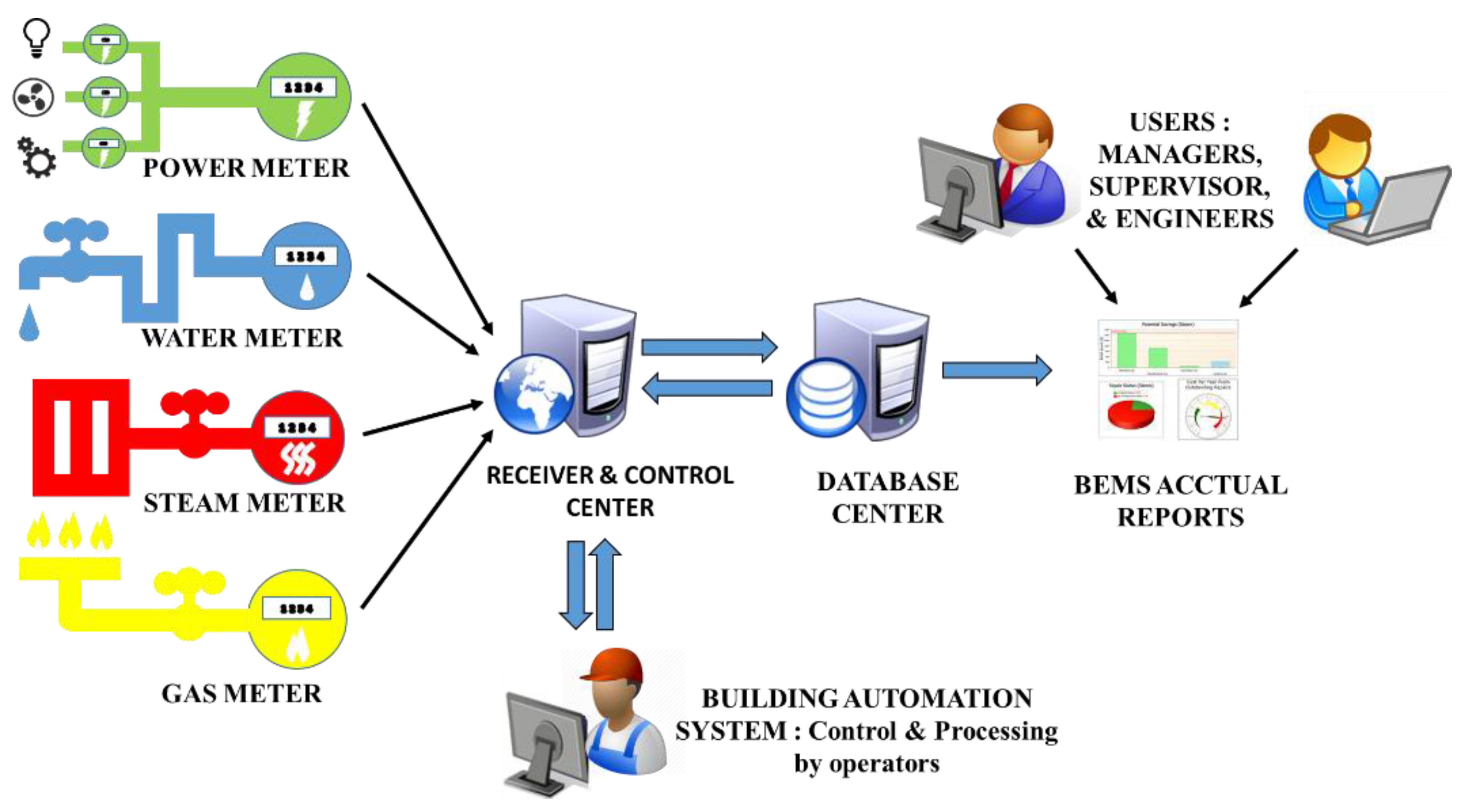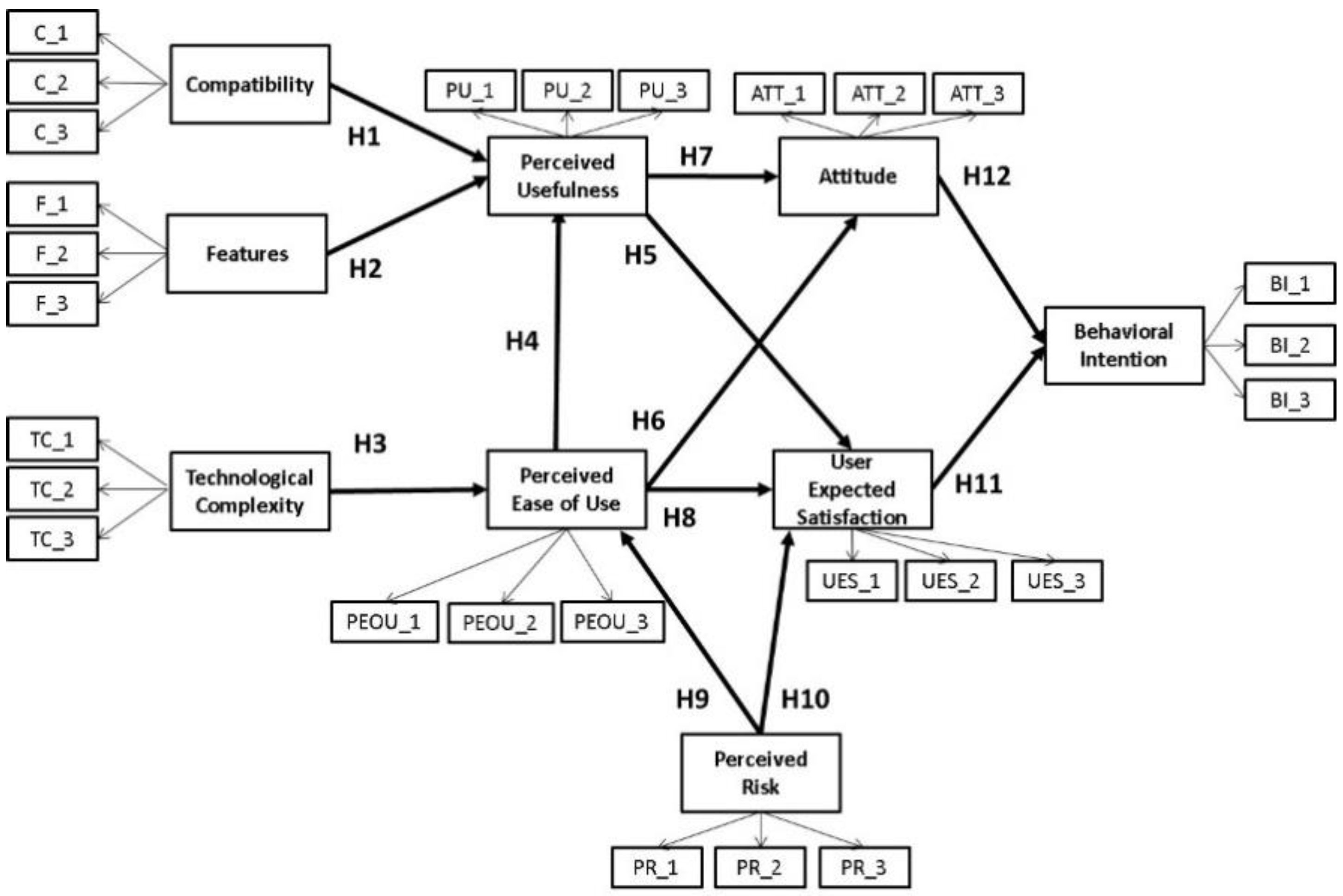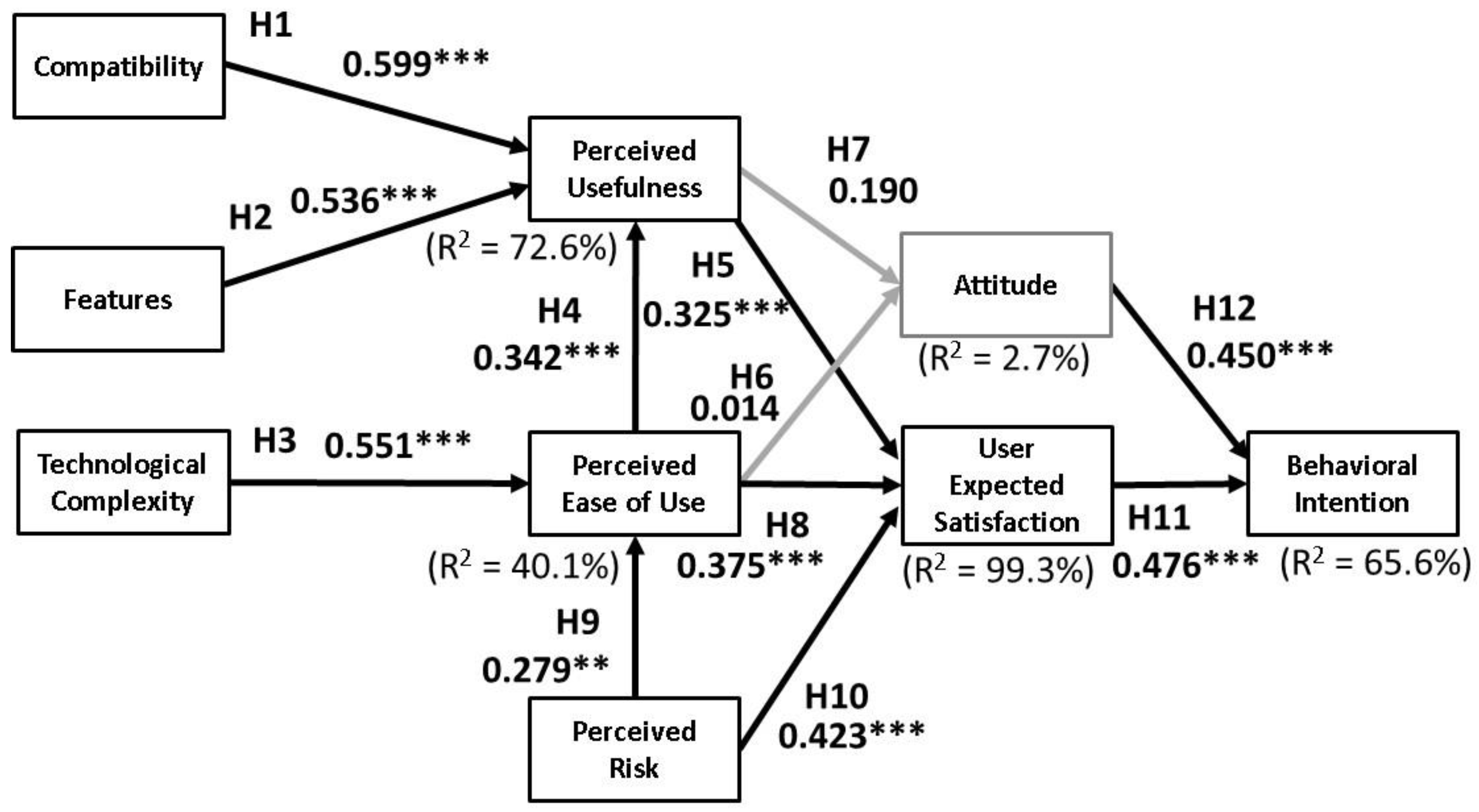1. Introduction
In 2014, the industrial sector became the leading sector among all sectors in Southeast Asia in terms of total energy consumption, with the sector’s consumption rising by an average of 4.2% per year [
1]. Indonesia is currently the largest energy consumer in southeast Asia, accounting for 36% of the region’s total primary consumption [
2]. As noted, the sector with the greatest share of total energy consumption is the industrial sector, which accounts for 33% of the total, followed by the residential sector and the transportation sector, at 27% each, and then the commercial sector combined with other sectors at 10% [
3]. As a result of the competitive environment of the energy industry in the look of the current global economic challenges [
4], Indonesia faces numerous challenges including the growing demand for energy and the increased costs associated with the energy. Achieving energy efficiency is undoubtedly one of the best strategies for companies to run and maintain sustainable processes. With a good monitoring system for controlling energy usage, companies can reduce the cost of energy consumption while also helping to preserve the environment. To mitigate the issues of high-costing energy and the growing demand for the energy, many industries have been seeking to increase the role of energy efficiency in their cost-saving program. There has also been a considerable amount of attention placed on the integration of energy-efficient technologies, including the transformation of the traditional energy control system to the smart building energy management system. However, the lack of the Indonesian companies that comply with the changes in industries also becomes a problem, and would thus affect the stability of the energy consumption in this industrial sector. The Indonesian Energy Council Report of 2014 revealed a lack of integration within energy management systems among industries. As a result [
5], researchers, such as Maulidevi et al. [
6], also explained how the low efficiency affects the acceptance of the technology within an industry. Another set of research data by Kim indicates that company decisions would be directly affected by the manager’s intention to use a new system [
7]. In the end, a strong managerial intention to use an energy management system would attract potential employees with similar intention to use the new technology and thus, positively affecting the industry.
Success in implementing a new technology depends largely on the behavioral responses of users [
8,
9]. Within a company, individuals at the managerial level play an important role, not only in the direct implementation of a new technology, but also in ensuring that related systems are run successfully. In fact, leadership at the managerial level is the most critical factor for supporting the implementation of a system, particularly with regard to employees’ behavioral intention in terms of using the system. The aim of the present study was to investigate the factors that may influence managerial perspectives toward a particular energy management system that has been widely implemented in various industries.
In Southeast Asia, and in Indonesia in particular, a smart monitoring system has been introduced at a variety of companies in recent years [
1,
10]. In order to evaluate the effectiveness of energy consumption efficiency efforts, it is essential that a smart monitoring system be installed on-site at the location of interest. In industrial facilities, operators must continuously monitor and control many different utilities to ensure the proper operation of the facilities. The development of networking technology has made such monitoring and control increasingly feasible [
9]. These industrial monitoring and control systems are commonly called Supervisory Control and Data Acquisition (SCADA) systems, with the Building Energy Management System (BEMS) being a prominent example. Some recent articles have described that the practical implementation of the BEMS strongly supports reducing energy consumption when compared to conventional approaches [
11,
12,
13,
14,
15]. The present study investigated various factors that could potentially influence managerial acceptance of such systems. There have been several similar studies that successfully examined user behaviors toward a smart BEMS through the Technology Acceptance Model (TAM), although those studies were focused on residential housing, commercial housing, and general-purpose energy usage [
8,
10,
16] instead of on energy usage in the manufacturing industry. This research, on the contrary, sought to examine the behaviors of BEMS users in manufacturing companies. The findings of this research can serve as a reference in designing guidelines for BEMS users, such as smart building grid meter companies, and BEMS providers and for improving a given BEMS in terms of managerial perceptions and behaviors.
4. Results Analysis
The analysis was carried out based on the 157 valid surveys, which were properly filled out by the managerial professional respondents. All of the respondents were from manufacturing companies in Indonesia that use the building energy management system for energy consumption monitoring. In terms of age, 24% of the respondents were 25–34 years old, while 76% were older than 34 years old. In terms of work experience, 19% of the respondents had between one and five years of experience at their current workplace, while 81% had more than five years.
As SEM is appropriate for testing the proposed model, we used the maximum likelihood method to test the fit of the model. The first step was to test the reliability and convergent validity of the survey items [
43]. As illustrated in
Table 3, every single value of the factors loading in the proposed model was satisfactory and exceeded the recommended minimum measurement (0.7) [
44,
45,
46]. The resulting values indicated that our model was an appropriate explanation for the dimensionality of all the factors. The next measurement was Cronbach’s α. Testing results showed that all questionnaire items exceeded the recommended minimum measurement of the Cronbach’s α value (0.7). The measurements of composite reliability for all items exceeded the minimum requirement (>0.6), showed that all the items pass the reliability test. All of the nine factors showed an adequate convergent validity, as they exceeded the recommended minimum measurement for the AVE measures.
In order to check the discriminant validity among the constructs, the AVE square root must be greater than the correlations with all constructs [
47,
48,
49,
50].
Table 4 presents the square root of the AVE and the correlations among the constructs. The given values indicate the adequate discriminant validity of the measurements [
51].
The experimental results showed that our model surpassed the requirements of model fit. All of the indicator results meet five conditions for the recommendation of model fit. As mentioned in the measurement model testing in
Table 5, the chi-square test (
X2/df) [
52], the root mean square error approximation (RMSEA) [
53], the goodness of fit statistic (GFI) [
54], the Tucker–Lewis index (TLI) [
55], and the comparative fit index (CFI) [
56], and these indices were chosen in order to determine how well the model fits the data [
57,
58].
As shown in
Table 6, all nine of the factors of this study have positive path correlations. However, out of the 12 proposed hypotheses, two were rejected (H6 and H7), and the rest were accepted. Furthermore, other findings indicated that C, F, TC, and PR would be positive predictors of behavior intention to use BEMS toward PU and PEOU.
R
2 values indicate the amount of variance in the construct from the path model [
47,
59]. The results indicate that the model explained 65.6% of the variance in behavior intention to use the BEMS. Similarly, 99.3% of the variance in user expected satisfaction, 2.7% of the variance in attitude, 72.6% of the variance in perceived of usefulness and 40.1% of the variance in perceived ease of use were explained by the result of paths model.
The relationship between the TAM and the external factors of BEMS is supported by the data given within
Table 6. The result shown is consistent with the previous finding within Chin and Lin’s study (2015) in predicting users’ intention through the PU and PEOU. All of the relationships between C (β = 0.599,
p < 0.001), F (β = 0.536,
p < 0.001) and PU were positive and statistically significant, and thus support H1 and H2. Furthermore, these antecedents explained 72.6% of the variance in perceived usefulness as well. The large variance of PEOU is explained by the perceived ease of use (R
2 = 0.401) being affected significantly and positively by technological complexity (β = 0.551,
p < 0.001) and perceived risk (β = 0.279,
p < 0.005), thus supporting H3 and H4. This meant that high compatibility, features, perceived risk, and technological complexity were strongly associated with perceived usefulness and perceived ease of use.
The results showed that neither PU (β = 0.014; p = 0.921) nor PEOU (β = 0.190; p = 0.159) had a significant effect on attitudes. In other words, since there was no sufficient statistical evidence to confirm the influence of PU and PEOU on ATT, H6 and H7 were not supported. Other findings showed that PU (β = 0.325, p < 0.001), PEOU (β = 0.375, p < 0.001), and PR (β = 0.423, p < 0.001) had significant influences on user expected satisfaction, which largely explains the large variance of user expected satisfaction (R2 = 0.993). Similarly, the results also showed that there is a positive and significant relationship between PU, PEOU, PR, and UES, and thus H5, H8 and H10 were supported. The coefficient in between behavioral intention, user expected satisfaction (H11), and attitude (H12) were also found to be significant with a value of UES (β = 0.476, p < 0.001) and ATT (β = 0.450, p < 0.001), which again largely explained the large variance of BI (R2 = 0.656).
5. Conclusions
This study addresses nine variables from the extended technology acceptance model regarding the building energy management system, and explores their causal relationships from a managerial perspective. The potential factors of compatibility, features, technological complexity, and perceived risk were incorporated as external factors into our proposed model. All of those factors influence user intention through the user expected satisfaction, perceived ease of use, and perceived usefulness factors. The results of the theoretical TAM from a managerial perspective were very useful for providing an understanding of aspects of user acceptance of BEMS technology in the manufacturing industry in Indonesia.
Overall, the SEM results supported the major hypotheses of this study and that the model adoption of the TAM was positively related to all the external factors, including compatibility, features, technological complexity, and perceived risk. These findings are consistent with previous findings related to the interactions of users with a smart grid [
10,
16]. In the proposed model, most of the direct relationship hypotheses between C, F, TC, PEOU, PU, UES and BI were supported, except those regarding direct relationships with ATT. The high positive correlation between external factors and original TAM factors are consistent with previous studies [
8,
10,
16]. This shows that the managerial level recognizes compatibility, features, technology complexity, and perceived risk as the dominant factors in the acceptance of BEMS. Through the factor analysis, we found that there were only insignificant direct relationships between perceived ease of use and perceived usefulness and attitude. Perceived ease of use and perceived usefulness did, however, have significant impacts on the UES. Another significant finding is that both PU and PEOU have a direct influence on user satisfaction, despite the absence of a direct relationship observed between PU, PEOU, and ATT. This result suggests that both factors, UES and ATT, were gained through PU and PEOU, differing from a prior study by Chou and Gusti [
10]. In other words, this finding specifically emphasizes the importance of developing a smart-building energy management system with a satisfactory decision-maker, which was not addressed in previous studies. Nevertheless, the attitude still significantly influenced the behavior intention in line as described in TAM by Davis [
24]. In our previous study, we have explored the factors affecting the acceptance of BEMS from the operator’s perspective in the manufacturing sector, and concluded that compatibility and technology complexity influenced the user’s intention through attitude, perceived usefulness and perceived ease of use [
3]. Although all were conducted in the same industry, these studies, which were conducted at different job levels, showed different conclusions, indicating that relationships among factors are affected by differences within the job level. This is due to managers’ behaviors varying from that of the operators or the field engineers, as they are the decision-makers of the industry. As a result, in our current study, the respondents are employees in managerial position. Based on the results of the present study, it clearly shows that, from a managerial perspective, user satisfaction with the system is viewed as being more important than the attitude of the users with the system. In addition, even if managerial level workers do not directly use the system, they can feel the effects of its usability after the system is up and running.
In order to understand technology acceptance from a managerial perspective, we developed a revised model with reconstructed variables from the proposed model. The relationships among the primary factors were significant in the final model, as explained in the path relation model (
Figure 3). The contribution of this study is to examine the relation of compatibility, features, technology complexity, and perceived risk as important variables to the behavioral intention. The results of our study support the conclusion that technical factors, such as compatibility, features, and technological complexity, are important concerns in the BEMS acceptance study. Therefore, the BEMS are supposed to deliver diverse duties into suitable computational systems in order to minimize their complexity, while still providing many features to meet management needs. The BEMS corporation ought to consider compatibility in their program application and features, as well as the technological complexity of their interface system to enhance the user experience in using the system. In light of these results, BEMS developers should maximize both the usefulness and ease of use of the BEMS since satisfaction depends heavily on these two factors. Specifically, BEMS developers should improve the user expected satisfaction of BEMS in terms of supporting energy-savings programs and government sustainability programs. Moreover, for data safety concerns and other risks, BEMS developers must also be able to ensure that data are secure from hackers and data error by implementing a cloud networking system that users would be able to access in order to monitor the history of energy consumption in their department from anywhere and at any time. The results of this managerial perspective study also indicate that various industries, especially those in developing countries, are willing to use BEMS in order to control, monitor, and analyze their energy consumption levels.
This study gives two implications for practitioners and researchers studying BEMS. The first implication is the ability of the extended TAM to be applied within the context of the new smart-building energy management system. As shown in the results of our proposed model, the four external variables have a positively significant impact on the acceptance of BEMS by those within the managerial level. The second implication is the tendency of users within the managerial level to put more emphasis on the amount of user satisfaction received during use of the system rather than on their attitude of the user towards the system itself. As a result, managerial users in industry have an increased tendency to make rational decisions based on the total satisfaction received while using the system. However, users within the operator level put more emphasis on the technical factors of the system such as compatibility and technology complexity on their attitudes to use a new technology. Therefore, the developers should factor in considerably the managerial perspective when planning to develop smart grid technology.
There were several limitations of this study, with the most noticeable limitation being the respondents’ demographic profiles. Since the respondents were all managerial workers in large scale manufacturing companies, the participants may not represent all of the workers within the industrial sector. Additionally, all of the participants were residing in Indonesia, which, although currently the largest energy consumer country in ASEAN, is still a developing country. It may also be noted that the results of similar studies conducted within developed countries and in sectors outside the manufacturing sector may vary from those of this study. As a result, further research on the implementation of BEMS, such as a comparative study, is suggested to be conducted between the managerial level and operator level as well as within other countries and sectors in order to balance the theoretical aspects of both management and operations, and thus be able to develop a more comprehensive model for BEMS.








